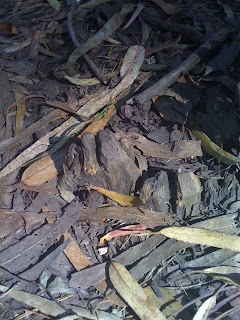
One of my favorite places to go walking is Lands End. There are several trails lining the cliffs, and one of the best views of the Golden Gate bridge there is. The area has a strange and varied history. I've decided to save some of that history for later posts because there is so much that is remarkable that it would be a shame to reveal it all at once.
When you first stroll down the upper trail between Fort Miley and The Palace of Legion of Honor, you might think you were walking through the forest prime evil. The large trees and overgrown brush give the impression that the area has always looked that way, the reality of it's fairly recent history nearly unbelievable.

The fact is people have tried to tame that corner of San Francisco since it has been a city, but time and again nature has won in the end. As recently as about 50 years ago that upper trail was a highway called the El Camino Del Mar. A series of landslides plagued the area until finally it was easier to let nature take the trail back over than it was to try and rebuild.


The amazing thing about it is the road is still there. The vegetation and huge trees that you can see there today grow with little or no trouble right through the pavement.
You would think they would have known better than to try and put a highway in that spot. El Camino Del Mar was not the first means of transportation to go sliding down that cliff side. From the 1880's through the early 20th century there was a railroad through there that would bring people to the Sutro Bath Houses for 5 cents. In 1925 it suffered the same fate.

Remnants of the old railroad can still be found at the site. Here, Mesa the German Shepard shows off her find of a rotten rail road tie with a spike still in it.


There are other tidbits for the amateur historian to ponder here. Three shipwrecks line the coast. From The El Camino Del Mar Trail you can see the remains of the Frank H. Buck,(wrecked in 1937), and the Lyman A. Stewart,(wrecked in 1922). You are supposedly able to see the wreck of the Ohian,(also wrecked in 1937) close by, but we have yet to come across it. Later that year the ships were dynamited to beautify the coastline. Old photos give a suggestion of what today cannot be seen beneath the waves, rumored to be revealed at low tide.


We are pretty certain that there is more to be revealed along this beautiful stretch of San Francisco park land. With each new discovery comes more research, and with more research comes new discovery. We'll keep you posted when we find things.
 On another afternoon we came across this stone tucked in a seldom explored area of the cliff side. We think it is probably what is left of a monument due to it's location within area that used to be part of the old Golden Gate cemetery at Lands End. Most of the stones were moved back in 1910. A golf course and the Legion of Honor occupy the land now. This stone was found in the steep, overgrown area within the trees, by the cliff's edge. The general form is refined, and looks broken. The markings appear to have been added much later by a not as skilled artisan as the person who made the pedastol.
On another afternoon we came across this stone tucked in a seldom explored area of the cliff side. We think it is probably what is left of a monument due to it's location within area that used to be part of the old Golden Gate cemetery at Lands End. Most of the stones were moved back in 1910. A golf course and the Legion of Honor occupy the land now. This stone was found in the steep, overgrown area within the trees, by the cliff's edge. The general form is refined, and looks broken. The markings appear to have been added much later by a not as skilled artisan as the person who made the pedastol.
 Then there was the day we were walking and heard a crackling, or popping sound. When we followed the sound we came across 6 or 8 of San Francisco's wild parrot population stripping a bush of it's berries. Legend has it that the wild parrots came in the late 70's, an escaped pet store shipment that managed to survive in the wild and breed. If you have ever heard these birds, the sound is unmistakable. This group was found in the Presidio, by the Lombard Gate.
Then there was the day we were walking and heard a crackling, or popping sound. When we followed the sound we came across 6 or 8 of San Francisco's wild parrot population stripping a bush of it's berries. Legend has it that the wild parrots came in the late 70's, an escaped pet store shipment that managed to survive in the wild and breed. If you have ever heard these birds, the sound is unmistakable. This group was found in the Presidio, by the Lombard Gate.
 Finally, and one of my favorite places to visit is the labrinth at Eagle Point. The labrinth is tucked away off the main walking trail, right by the cliff's edge. It's delicate beauty enhances the already surreal view of the Golden Gate Bridge.
Finally, and one of my favorite places to visit is the labrinth at Eagle Point. The labrinth is tucked away off the main walking trail, right by the cliff's edge. It's delicate beauty enhances the already surreal view of the Golden Gate Bridge.
































